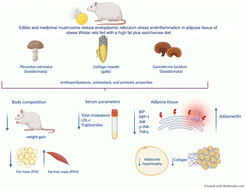Edible and medicinal mushrooms (Pleurotus ostreatus, Ustilago maydis, Ganoderma lucidum) reduce endoplasmic reticulum stress and inflammation in adipose tissue of obese Wistar rats fed with a high fat plus saccharose diet†
Abstract
Obesity is an increasing global public health problem. A strategy to treat obesity is the use of functional foods. Edible and medicinal mushrooms contain diverse bioactive compounds showing important antihyperlipidemic, antioxidant, and prebiotic properties. We analysed the effects of adding (10%) of Pleurotus ostreatus (Po, basidiomata), Ganoderma lucidum (Gl, basidiomata), or Ustilago maydis (Um, galls), milled, to a high fat plus saccharose diet (HFD + S) for 6 months in a model of obesity with Wistar rats. We assessed weight gain, body composition, lipid parameters, endoplasmic reticulum stress (proteins and inflammatory markers: BiP, XBP-1, JNK, p-JNK, TNF-α), and adiponectin in subcutaneous adipose tissue (SAT). The consumption of edible and medicinal mushrooms decreased weight gain (−17.2–30.1%) and fat mass (−23.7–43.1%), maintained fat-free mass, reduced levels of serum biochemical parameters (TC: −40.1–44.1%, TG: −37.7–51.6%, LDL-C: −64.5–71.1%), and prevented adipocyte hypertrophy (−30.9–36.9%) and collagen deposition (−70.9–73.7%) in SAT. Compared with the HFD + S group, mushroom consumption by Wistar rats significantly reduced the expression of proteins associated with endoplasmic reticulum stress and inflammation (BiP: −72.2–88.2%; XBP-1: −71.5–81.8%; JNK: −71.2–90.0%; p-JNK: −37.3–81.0%; TNF-α: −80.7–91.5%), whereas significantly increased adiponectin protein expression (246.4–654.2%) in SAT. These effects outperformed those obtained through the commercial lipid-lowering drug atorvastatin, contributing synergistically to prevent further obesity-related dysfunctions, such as insulin resistance derived from inflammation and ER stress in adipose tissue. Bioactive compounds from edible, functional and medicinal mushrooms represent new emerging therapies for obesity treatments using natural products.



 Please wait while we load your content...
Please wait while we load your content...